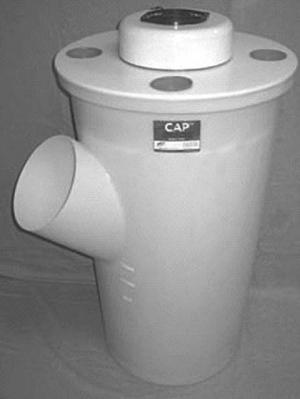Livestock Ammonia Fighter
 ✖  |
You can take the odor and more out of poultry and livestock barns with a Clean Air Plant (CAP) from VentilationUSA LLC. The proven CAP technology will help livestock producers meet the new government legislation requiring the reduction of ammonia (NH3). Using a technique called biological oxidation, the CAP units capture and destroy gasses, volatile organic compounds, ammonia odors, as well as remove particulates from the air. All that is released is clean air, a little carbon dioxide and water.
"We have goals of reducing ammonia to save energy, improve animal health and growth while helping the environment," say Richard Egan, VentilationUSA. "If livestock producers can reduce the ammonia levels without using fans to exhaust it, they will save energy in the cold weather."
Egan says CAP technology has been used successfully in printing plants and ink manufactures to reduce pure ammonia levels by 90%. He is now wants to apply that technology to agriculture such as chicken grow houses and horse barns.
A fan at the top of the unit pulls pollutants up into the bio cartridge stack to be oxidized by the enzymes while cascading water washes out the system. Gasses and organic particulates are consumed in the oxidation process. Even molds, fungal spores, viruses and bacteria are destroyed by the enzymes.
A small submersible pump recirculates the water over a cartridge where heavy metals and non-organic particles are washed away into the base.
A CAP 600 is 30-in dia at the top and narrows down to 26in. at the base. It is 48-in tall and is designed to control pollutants in areas up to 5,000 sq.ft. depending on the pollutant load. It is equivalent to a venting flow rate of 5,000 CFM, yet only releases CO2 and water. The unit can consume and destroy up to 60 lbs. of pollutants per day.
Every situation is different, and the number and size of the units needed depends in the concentration of animals, explains Egan. Moisture can also be a factor. In a chicken or swine environment, you might need to use and air to air heat exchanger system to reduce the moisture in the winter, in conjunction with the CAP's.
Egan says the unit should pay for themselves in improved animal health, more efficient growth and better work environment with less pollution to the environment, with less neighbor complaints.
Contact: FARM SHOW follow up, VentilationUSA LLC, P.O. Box 4360, Manchester, NH 03018 (ph603 622 1791 or 800 622 8078; email: info@ventusa.com; website: www.ventusa.com).

Click here to download page story appeared in.
Livestock Ammonia Fighter BUILDINGS Livestock 90-10-100 You can take the odor and more out of poultry and livestock barns with a Clean Air Plant (CAP) from VentilationUSA LLC. The proven CAP technology will help livestock producers meet the new government legislation requiring the reduction of ammonia (NH3). Using a technique called biological oxidation, the CAP units capture and destroy gasses, volatile organic compounds, ammonia odors, as well as remove particulates from the air. All that is released is clean air, a little carbon dioxide and water.
"We have goals of reducing ammonia to save energy, improve animal health and growth while helping the environment," say Richard Egan, VentilationUSA. "If livestock producers can reduce the ammonia levels without using fans to exhaust it, they will save energy in the cold weather."
Egan says CAP technology has been used successfully in printing plants and ink manufactures to reduce pure ammonia levels by 90%. He is now wants to apply that technology to agriculture such as chicken grow houses and horse barns.
A fan at the top of the unit pulls pollutants up into the bio cartridge stack to be oxidized by the enzymes while cascading water washes out the system. Gasses and organic particulates are consumed in the oxidation process. Even molds, fungal spores, viruses and bacteria are destroyed by the enzymes.
A small submersible pump recirculates the water over a cartridge where heavy metals and non-organic particles are washed away into the base.
A CAP 600 is 30-in dia at the top and narrows down to 26in. at the base. It is 48-in tall and is designed to control pollutants in areas up to 5,000 sq.ft. depending on the pollutant load. It is equivalent to a venting flow rate of 5,000 CFM, yet only releases CO2 and water. The unit can consume and destroy up to 60 lbs. of pollutants per day.
Every situation is different, and the number and size of the units needed depends in the concentration of animals, explains Egan. Moisture can also be a factor. In a chicken or swine environment, you might need to use and air to air heat exchanger system to reduce the moisture in the winter, in conjunction with the CAP's.
Egan says the unit should pay for themselves in improved animal health, more efficient growth and better work environment with less pollution to the environment, with less neighbor complaints.
Contact: FARM SHOW follow up, VentilationUSA LLC, P.O. Box 4360, Manchester, NH 03018 (ph603 622 1791 or 800 622 8078; email: info@ventusa.com; website: www.ventusa.com).
To read the rest of this story, download this issue below or click
here to register with your account number.






